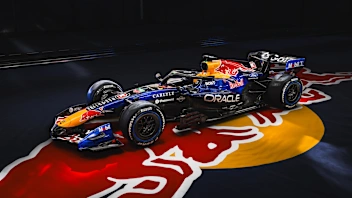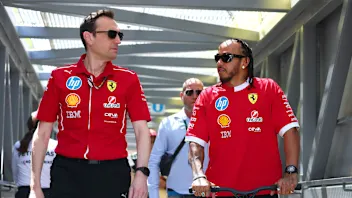“Eau Rouge,” says McLaren’s Jenson Button, “is one of those fabled corners that drivers and fans always talk about - but it really is that special.” On the eve of the 2016 Formula 1 Belgian Grand Prix, we investigate how Spa-Francorchamps’ most famous section has evolved from the earliest days of the world championship...
The 1950s
The characteristic down-up sweep of Eau Rouge, named for the red-hued, iron-rich stream running beneath it, has been used in every iteration of Spa since the world championship began in 1950. However, when cars first started racing there in the 1920s, Eau Rouge was a sharp left-hander which took the drivers off towards a hairpin in the direction of the German border. But seeking to improve the average speed of what was already a supremely quick circuit, track bosses decided to create an ‘artificial’ uphill sweep in order to bypass the slow section. If you look closely at these pictures from the 1950s you can still see the old left-hander at the bottom of the hill, just after the brick wall denoting the edge of the bridge. As you can see, there were initially no barriers at the corner, though a low-level metal Armco barrier was added to the inside of the uphill section in the mid-Fifties. Of course, what these pictures struggle to get across is just how steep the hill is - such is the gradient that Michael Schumacher once said that approaching Eau Rouge was like “flying downhill and seeing a big mountain in front of you”.
The 1960s
As these pictures show, there were no major changes to Eau Rouge in the Sixties, save for the addition of advertising banners to the bridge. Safety precautions at the corner remained minimal at best, with an unforgiving stone wall lining the outside of the bend all the way from the bottom of the hill to Raidillon (the final left-hander at the crest of the hill). But that was the least of Jim Clark’s worries during practice in 1966: "I was taking the hill from Eau Rouge at 130mph and taking my line through the bend when I came across this [road] car moving at a quarter of my speed. It was all I could do to stay out of the trees..."
The 1970s
Concerns from the Grand Prix Drivers Association over rising speeds, dangerous road surfaces and inadequate safety barriers led to the cancellation of the 1969 race, but the event returned in 1970, by which time Eau Rouge had been lined with protective Armco. Catch fencing - very popular at the time - had also been added at the bottom of the corner. However, it would prove to be the last Grand Prix at Spa for 13 years, with the championship’s Belgian round moving first to Nivelles and then Zolder. It’s worth remembering that Spa used to be made up entirely of public roads - hence the road markings and graffiti shown in these pictures. The track was shortened from 14.1 km to its current length in 1979, but it wasn’t until 2000 that it became a dedicated race circuit.
The 1980s
After eight successive races at the universally unpopular Zolder circuit, the drivers were delighted when the Belgian Grand Prix returned to Spa for a one-off race in 1983 (ahead of a permanent return in 1985). The good news was that Eau Rouge remained as great a challenge as ever, with the only modifications being marginally increased run-off, better Armco barriers, the addition of tyre walls at the bottom of the hill and new entry and exit kerbing on the track edges. Tragically, rising F1 star Stefan Bellof would lose his life at the corner during a sportscar race in 1985, but as the decade went on, so the safety precautions improved, with tyre barriers extended and run-off areas upgraded. From a visual point of view, the low-slung cars of the era made the legendary section practically pyrotechnic, with cars spewing out sparks as they hit the compression at the bottom of the hill. And now that they have titanium skid blocks, the current breed of cars are just as spectacular.
The 1990s
Eau Rouge was the scene of several major crashes in the Nineties. In 1993 Alex Zanardi was lucky to escape major injury when his Lotus suffered a mechanical issue and smashed into the wall midway up the hill. That incident increased speculation that, for safety reasons, the corner might one day have to be re-profiled to a chicane - a suggestion that outraged Ayrton Senna. "If you take away Eau Rouge," the five-time Belgian winner said, "you take away the reason why I do this..." The sad irony was that it was Senna’s death - and the subsequent safety backlash - that led to a chicane being installed at the corner in 1994. The section would return to its visceral best the following year, albeit with additional tyre barriers, gravel traps and run-off areas. In 1999 the wall was moved back from the inside of the right hander, prompting Jacques Villeneuve to say: “The corner’s easier now - visually it’s not as impressive as it used to be. It’s going to be flat-out…” The Canadian’s words would come back to haunt him. In qualifying Villeneuve and BAR team mate Ricciardo Zonta dared one another to take the corner without lifting - and both suffered massive accidents. However, advances in aerodynamic performance meant that the following year many found that Eau Rouge could indeed be taken flat in top gear on low fuel.
The 2000s
The beginning of the decade saw the gravel trap on the outside of the corner replaced with asphalt as the push for improved safety continued, while the support paddock pit lane exit was moved to the inside of the corner. The exit kerb at the top of the hill was also flattened, helping ensure drivers continued to take Eau Rouge at nerve-shredding speeds. However, not everyone was happy that an element of jeopardy had been removed. "I always enjoy driving here, but it was easy to take Eau Rouge flat today,” Villeneuve said in 2002. “With traction control and high grip it's now the same for everybody." But it wasn’t until 2006 - when the engine formula changed from 3.0-litre V10s to 2.4-litre V8s - that most drivers agreed that Eau Rouge had become easier to drive, though many were keen to point out that it still a real challenge in the wet or on full tanks. Speaking in 2008, Mark Webber said he approved of the changes. “The challenge is not as it used to be, with the V10s we used to arrive there right on the edge, and in the tyre war days it was quick. But now the cars are a bit more stable through there. You certainly want your car to stay together through there, as it will be a massive shunt if you have any mechanical failures at any stage through that section. They have done a really good compromise on it. You can still go in hard there if you get it wrong, if the tyre pressures are out or the plank [on the floor of the car] touches."
2010 - Today
Eau Rouge has remained broadly the same since the turn of the decade, though the evolution of technology has continued to make it an ever-changing challenge for the drivers. The advent of the F-duct in 2010 led to some negotiating the corner one-handed so as to ensure the aerodynamic aid was activated efficiently, while when the DRS was introduced in 2011 the drivers were banned from using it in Eau Rouge because of safety concerns. The introduction of the latest generation of power units in 2014 changed the game once more, with the drivers now unanimous in their belief that the legendary corner is a true challenge once more - especially in the wet. "The feeling of the sweep uphill through the corners is just awesome, every time," says Jenson Button. "Eau Rouge is always the most exciting part of the circuit," Lewis Hamilton concurs. "When you attack it flat out, when you get to the bottom of it, your insides drop. And then when you get to the top they come back up and it feels like everything will come out of your mouth - which is quite exciting when you are going 200mph!"
Next Up
Related Articles
 Red Bull unveil striking new livery for 2026
Red Bull unveil striking new livery for 2026/TEAM%20PREVIEWSHALF%20TERM%20REPORTS%20V1%20(13).webp) Team Previews 2026All you need to know about Racing Bulls
Team Previews 2026All you need to know about Racing Bulls Grosjean reunited with helmet from 2020 Bahrain GP crash
Grosjean reunited with helmet from 2020 Bahrain GP crash Logan Sargeant confirmed as Ford WEC Hypercar driver
Logan Sargeant confirmed as Ford WEC Hypercar driver/SI202601151081.webp) Racing Bulls launch 2026 livery in Detroit
Racing Bulls launch 2026 livery in Detroit Hamilton to get new Ferrari race engineer for 2026 season
Hamilton to get new Ferrari race engineer for 2026 season